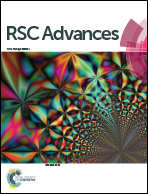Selective extraction of bioactive glycoprotein in neutral environment through Concanavalin A mediated template immobilization and dopamine surface imprinting
Abstract
Glycoproteins play important roles in various biological events. Extraction of specific bioactive glycoproteins from physiological fluids is highly required for clinical diagnosis and treatment. Concanavalin A (Con A) is a tetramer lectin protein that can specifically bind glycospecies containing sugar units, and this binding occurs in physiological environments. Inspired by this, we propose a sugar–lectin recognition based glycoprotein surface imprint, which is anticipated to selectively extract bioactive glycoproteins in physiological environments. The glycosylated biomarker, transferrin, was used as a model template. Transferrin was first immobilized on a Con A modified Fe3O4 surface via the sugar–lectin interaction at pH 7.4. Dopamine was then polymerized onto this surface for glycoprotein imprinting at the same pH, and continuous oxygen bubbling into the dopamine solution improved the polymerization speed. After removal of the template by boronate buffer, transferrin imprinted Fe3O4 was obtained. The subsequent binding experiment indicated that the transferrin imprint has pH dependent binding affinity towards this protein. The optimal transferrin binding capacity, as well as the maximum imprinting factor was observed at neutral pH. The isotherm adsorption study reveals that imprinted and non-imprinted material are both fitted with the Langmuir adsorption model. Single selective adsorption and competitive adsorption experiments show that the obtained surface imprint has selectivity towards template glycoprotein, and circular dichroism (CD) spectral analysis indicates that boronate buffer washing has no negative influence on the natural structure of transferrin and Con A. These results demonstrate that this novel glycoprotein surface imprint can work under physiological conditions, and the glycoprotein extraction method is mild enough to keep the bioactivity of these targets for further bio-application.


 Please wait while we load your content...
Please wait while we load your content...